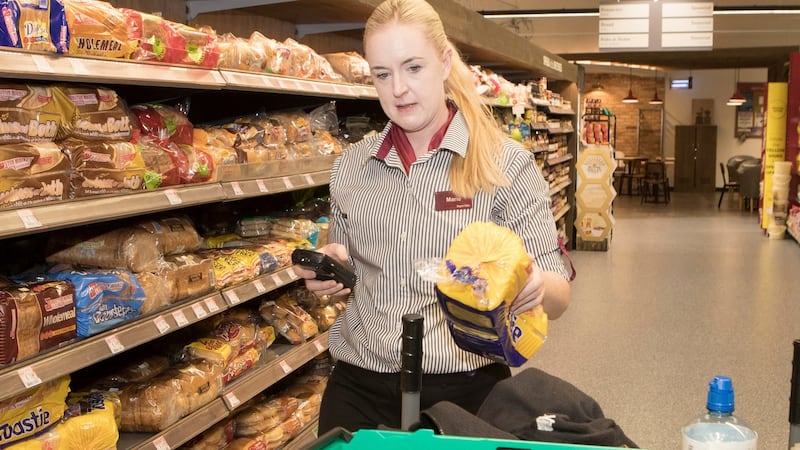Marie McMahon is moving with the speed of a rollerblader among the aisles of SuperValu’s Castletroy branch in Limerick.
McMahon is a full-time “picker” and driver of home-delivery groceries. She is one of a team of five pickers and three drivers, who service up to 300 online orders a week, driving as far as Nenagh in Co Tipperary and Ennis in Co Clare to deliver.
Each aisle in SuperValu Castletroy has a designated staff member, who must be closely familiar with the items shelved there. With more than 20,000 products in this shop, and all of them available to buy online, a picker of groceries needs as much help as they can get.

It’s a Monday morning, and there are 41 online orders for home delivery in already. All the orders are initially filtered through the head office in Dublin, and then sent to the relevant shop locally. The previous week, the Castletroy shop had made 152 home deliveries. With an average customer spend of €120 per order, that’s a lot of items to find, pack and deliver.
I am following McMahon as she fills an order for a long-standing customer. It sounds obvious, but hand-picking a weekly shop is time-consuming. A picker here in Castletroy gets through an average of 72 items an hour. McMahon has a trolley with a stack of crates, which double as delivery boxes. (Everything is unpacked in the customer’s home, and the crates reused.)
The circuit of the supermarket starts with what I’m told are “ambient” products: ie, those non-perishable and non-chilled items. Then fruit and vegetables, then chilled items and lastly, frozen foods.
When the orders come in, they are downloaded to a hand-held device called a “gun”. McMahon works through the list, scanning each item as she removes it from the shelf. There are also visits to the meat and fish counters, where she has to weigh, price and scan each item; each one taking more time than simply removing an item from a shelf.
The “gun” also helps to locate – among the 20,000 products in the shop – the particular items which a customer has ordered. McMahon pauses by the wine aisle and glances down at the device. “This tells me the country of origin of the wine and if it is red or white. In the past, all I got was the name of the wine and it could take ages,” she says. “With wine, I can tell if customers are choosing wine because of price deals, or because of preference.”

If they are delivering an order that includes alcohol and a minor answers the door with no adult at home, the driver must return the alcohol, and the customer will be refunded.
The logistics of the whole exercise begin to boggle my head. Most supermarket customers – or at least in my own case – spend time wandering the aisles back and forth, searching. To be an efficient picker of someone else’s groceries, McMahon needs to know where everything is.
She shows me her Fitbit, which records how many steps she takes a day: she has no problem reaching the recommended 10,000 a day.
There are only two vans at the moment, and as each one covers a different geographic area; they can’t leave until they have the requisite number of orders for those areas filled. And those boxes won’t fill themselves.
“It is kind of mad,” McMahon points out, in between fetching granola, biscuits, and eggs. “People get paid to put stuff on the shelves and then I get paid to take it off again.”
The fact is, as SuperValu know well, if they didn’t offer the service to customers who are currently ordering online, those customers would take their business to a competitor.
The demand for home-delivered groceries is growing in Ireland. SuperValu offers home delivery in 107 of its shops, for a delivery fee that varies depending on the time of day. Last year, 26,000 new customers used their online shopping service; a service which also includes “Click and Collect”, where a staff member picks the groceries, and the customer collects in-store.

‘Would I buy that?’
Today, McMahon will pick four orders, as well as making some deliveries. She keeps going, flying up and down the aisles. Red lentils; peanuts; brown pitta bread; tinned chick peas; wholemeal bagels; red-wine vinegar; bay leaves; golden syrup; oat milk; fresh basil; garlic; and coriander.
“We have a lot of regular customers,” she says. “Older people, new parents, businesses, people in supported living.”
McMahon isn’t just selecting the first items, closest to the front of the shelf or the chilled cabinet. She chooses products that have the longest time-frame for freshness. “I keep asking myself: would I buy that?” she says, explaining that this is the shop’s quality-control training mantra.
If an item is out of stock, the customer is called. If the customer agrees to a similar replacement item, then it goes in. If they wanted the specific out-of-stock item, then it’s left off the list. Substituting an item without customer approval is not their policy, although they are aware that some other supermarkets offering home delivery do this, and that it is a big source of annoyance to those customers.

There are 60 “slots” a week: a slot is a delivery time of up to two hours; ie, if you order online, your groceries will arrive during a particular two-hour window. If you get your order in before noon, it will be delivered the same day. These hours mean pickers begin their working day at 6am, and drivers at 9am. In December, unsurprisingly their busiest month, pickers can start at 3am.
One van has already gone out this Monday morning and made four drops. McMahon is now going out with a number of deliveries. It slowly becomes clear to me how time-consuming the entire process is.
Processing the online orders;delegating the orders to pickers; figuring out which geographical locations are closest together; getting the order list and receipts into envelopes; loading the truck.
We drive a good 20 minutes to make the first delivery. Claire Connell is a long-standing customer. McMahon and she know one another, and the chat is about when playschool is starting.
As McMahon unloads the crates, Connell explains why she uses the service. “We get a delivery once a week. I’m on a career break, and we only have one car. The two kids [18 months and three] are very small, and it is a lot less stressful to shop this way.” The family came back from holidays the evening before. “And now, here’s the weekly shop, delivered before lunch,” she says.
Back in the van, driving to the next drop-off, McMahon tells me she herself uses online home delivery. “The last thing I want after picking groceries for other people all day is go shopping for myself,” she says.




















